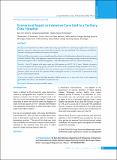Please use this identifier to cite or link to this item:
https://hdl.handle.net/20.500.14356/1222Full metadata record
| DC Field | Value | Language |
|---|---|---|
| dc.contributor.author | Ghimire, Ram Hari | - |
| dc.contributor.author | Budhathoki, Sampanna | - |
| dc.contributor.author | Shreewastav, Rupesh Kumar | - |
| dc.date.accessioned | 2023-05-03T06:52:01Z | - |
| dc.date.available | 2023-05-03T06:52:01Z | - |
| dc.date.issued | 2020 | - |
| dc.identifier.citation | GhimireR. H., BudhathokiS., & ShreewastavR. K. (2020). Scenario of Sepsis in Intensive Care Unit in a Tertiary Care Hospital. Journal of Nepal Health Research Council, 18(1), 99-102. https://doi.org/10.33314/jnhrc.v18i1.2498 | en_US |
| dc.identifier.issn | Print ISSN: 1727-5482; Online ISSN: 1999-6217 | - |
| dc.identifier.uri | http://103.69.126.140:8080/handle/20.500.14356/1222 | - |
| dc.description | Original Article | en_US |
| dc.description.abstract | Abstract Background: Sepsis has been defined as life-threatening organ dysfunction caused by dysregulated host response to infection. Sepsis is an important cause of mortality in intensive care unit worldwide. The study aims to identify the outcome of sepsis patient admitted at tertiary care hospital. Methods: This is a descriptive cross-sectional hospital based study on 76 adult patients admitted at intensive care unit of Nobel Medical College with diagnosis of sepsis with an objective of estimating mortality of sepsis and identifying associated symptoms with it. Baseline demographics, clinical and laboratory data were collected and analyzed. Results: Out of 76 patients with sepsis, mean age of the patients was 50.07±18.15 years. Majority of patients 31.6% with sepsis were above age groups >60 years. The most common symptoms among the patients were fever, which was seen in 69 (90.8%) patients. The most common source of infection in those patients was found to be unknown, which was seen in 36.8% of patients. While analyzing the outcome, it was noted that 25 patients with sepsis (32.9%) died during treatment. Conclusions: Sepsis is related with high mortality. Elderly patients are at more risk. Fever is the commonest presentation and source is not identified in majority of cases. Keywords: Intensive care unit; mortality; sepsis. | en_US |
| dc.language.iso | en | en_US |
| dc.publisher | Nepal Health Research Council | en_US |
| dc.relation.ispartofseries | JNHRC Print ISSN: 1727-5482; Online ISSN: 1999-6217; | - |
| dc.subject | Intensive care unit | en_US |
| dc.subject | Mortality | en_US |
| dc.subject | Sepsis | en_US |
| dc.title | Scenario of Sepsis in Intensive Care Unit in a Tertiary Care Hospital | en_US |
| dc.type | Journal Article | en_US |
| local.journal.category | Original Article | - |
| Appears in Collections: | Vol. 18 No. 1 (2020): Vol. 18 No. 1 Issue 46 Jan-Mar 2020 | |
Files in This Item:
| File | Description | Size | Format | |
|---|---|---|---|---|
| 2498-Manuscript-14318-1-10-20200420.pdf | Fulltext Article. | 251.17 kB | Adobe PDF |  View/Open |
Items in DSpace are protected by copyright, with all rights reserved, unless otherwise indicated.
